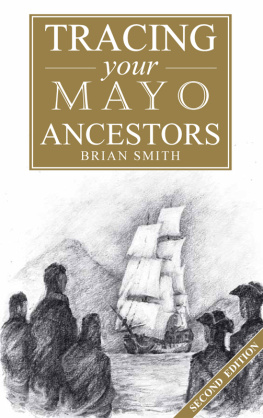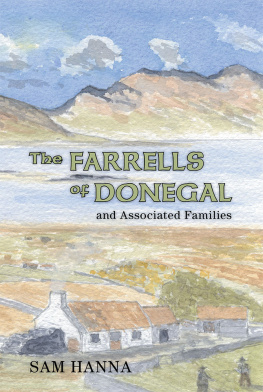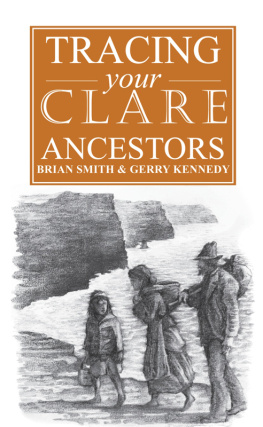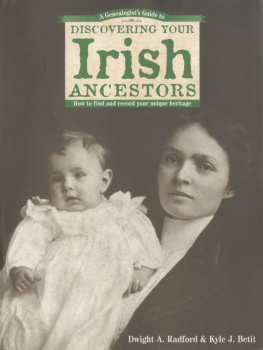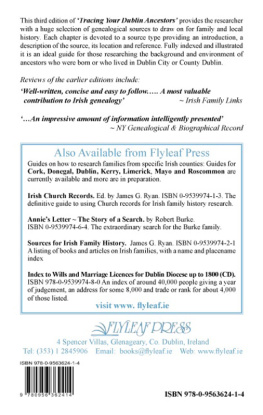All rights reserved. No part of this publication may be reproduced, stored in a retrieval system, or transmitted, in any form or by any means, electronic, mechanical photocopying, recording or otherwise without the prior permission of the copyright owner.
The information in this book is subject to change without notice.
Page layout by Brian Smith.
Dedications
Helen Meehan:To my late father, Robert Montgomery.
Godfrey Duffy:To my late father, Frank, whose pride in his Clonmany roots was an inspiration to me.
Acknowledgements
Helen Meehan wishes to thank the following for their valuable assistance:
NAI Gregory OConnor and Rosaleen Underwood
Manuscript Department of the NLI Mire N Chonaillain
Folklore Dept U.C.D. Seamus Cathain, Cristoir MacCarthaigh and Bairbre Ni Fhloinn.
RIA Siobhan Fitzpatrick.
Ulster Historical Foundation, Belfast William Roulston.
PRONI Heather Stanley
Central Library, Belfast Jim Rutherdale
University of Limerick Dr. Matthew Potter.
Donegal County Library - Eileen Burgess and her staff, especially Bernie Campbell and Una Matthewson.
Donegal Archives Niamh Brennan and Ciara Joyce.
Donegal Ancestry Susan McCaffrey.
Enniskillen Library Marianna Maguire and Margaret Kane
Omagh Library Belinda Mahaffy.
Cardinal OFiach Library, Armagh Roddy Hegarty
Central Library, Derry Gerry Quinn and Jean Nioclas.
Also Sean Beattie, Editor of Donegal Annual; Committee members of the Donegal Historical
Society; Margaret Graham, Laghey; Mick and Pauline Maule-Oatway, Ascot, U.K.; the Coane-Leibell family, Connecticut USA; Eunan ODonnell, Ardara and Kings Inns, Dublin and Aine N Dhuibhne of the Rathmullan and District History Society.
A special word of thanks to my family: Dr. Eucharia, Rosaire, Edward and Roberta and especially my husband John for their patience and encouragement.
Godfrey Duffy wishes to thank the following for their valuable assistance: The NAI; The NLI; New York Public Library; Donegal Ancestry; Buckinghamshire County Council Archives; PRONI; The National Archives (London); Sean Beattie, Editor of the Donegal Annual; Catherine McWilliams, Historian and Genealogist; and Marius OhEarcain, Editor of Its Us Theyre Talking About and a founder member of the Clonmany Festival and McGlinchey Summer School.
Table of Contents
Abbreviations Used
| BL | British Library |
| BMD | Births, marriages and deaths |
| c. | circa (around) |
| Co. | County |
| C of I | Church of Ireland |
| DAL | Donegal Ancestry Ltd. (see p. 149) |
| DCA | Donegal County Archives (see p. 149) |
| DCL | Donegal County Library |
| DHS | Donegal Historical Society (see p. 149) |
| Don. Ann. | Donegal Annual (see p. 149) |
| Ed. | Edited |
| GO | Genealogical Office |
| GRO | General Register Office |
| IED | Irish Emigration Database |
| IGRS | Irish Genealogical Research Society |
| IMC | Irish Manuscripts Commission |
| Inc. | including |
| JAPMD | Journal of Assoc for Preservation of Memorials of the Dead |
| KA | Kabristan Archives (See p. 68) |
| LC | Local Custody |
| LDS | Church of Jesus Christ of Latter Day Saints Family History Library |
| LHL | Linenhall Library |
| Ms(s) | manuscript(s) |
| NAI | National Archives of Ireland |
| n.d. | no date |
| NLI | National Library of Ireland |
| NS | National School |
| OS | Ordnance Survey |
| PLU | Poor Law Union |
| PRO | Public Record Office (Now part of National Archives) |
| PRONI | Public Record Office of Northern Ireland |
| pub. | published/publisher |
| RC | Roman Catholic |
| RCBL | Representative Church Body Library (see p. 147) |
| re | relating to |
| RIA | Royal Irish Academy (see p. 146) |
| UCD | University College Dublin. Archives see www.ucd.ie/archives/ |
Chapter 1 Introduction
Geographically in the North and politically in the South, Co. Donegal is situated in the North West corner of Ireland.
The county can be divided into four main regions in the extreme north, between Lough Foyle and Lough Swilly, lies the Inishowen Peninsula, containing the Baronies of Inishowen East and West. To the south between the Foyle, Finn and Swilly rivers lies the Laggan the most fertile part of the county containing the Baronies of Raphoe North and South.
West and North of the Laggan are the Donegal Highlands the most barren and least fertile part of the county containing the Baronies of Boylagh and Kilmacrennan. South of the Blue Stacks Mountains lies the Donegal Bay area the most fertile part being the coastal area between Killybegs and Ballyshannon. It contains the Baronies of Banagh and Tyrhugh.
Traditionally Donegal depended largely on farming, fishing and associated industries. Tweed and other cottage industries also contributed considerably to the economy of the county. However, today the county hosts many overseas firms which give significant employment, as do the service industries.
The population of the county has fluctuated considerably over the past two centuries. It peaked in 1841 at 296,448, but by 1851, following the Great Famine, it had fallen to 255,158. The fall continued and by 1911 it was only 168,537. In 1926 after the establishment of the Free State the population was 152,508. It had fallen to its lowest by 1971 when the county population was down to 108,344. Since then the population has risen it was 137,575 in 2002 and 147,264 in 2006. This 7% growth is somewhat slower than the 8.2% recorded nationwide for the same period.
History
Donegal was populated from Neolithic times but we have no written records before the introduction of Christianity in the 5th century.
Early in the 5th century three sons of Niall of the Nine Hostages, the Gaelic King of Tara, came to the North West, defeated the early inhabitants and carved out kingdoms for themselves. From West of the Swilly to West of Barnes became Conals land known in Gaelic as Tr Chonaill, Inishowen Peninsula became Eoghans land and the area known today as the Laggan became the land of Enna. Over the centuries the Cinel Connal or Conalls people, spread East and conquered the Cinel Enna and the Cinel Eoghan moved East across the Foyle and carved out the new territories for themselves Tr Eoghan Eoghans land which has been anglicized to Tyrone.



